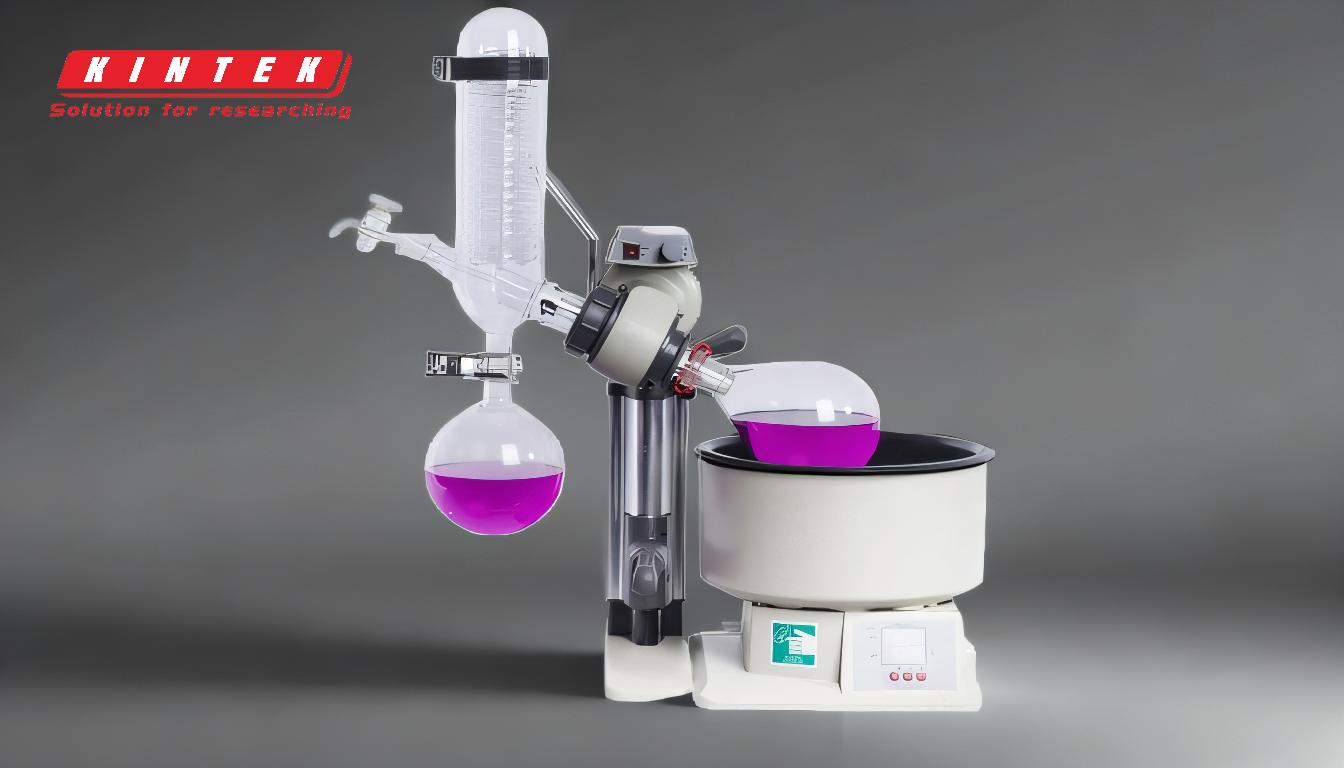Rotary evaporation is a critical technique in laboratory settings due to its ability to efficiently and gently remove solvents from samples, particularly those with high boiling points or heat-sensitive components. By operating under reduced pressure, rotary evaporators lower the boiling point of solvents, enabling faster evaporation at lower temperatures. This prevents unwanted side reactions such as oxidation or decomposition, which can occur at higher temperatures. Additionally, the formation of a thin film on the flask's inner surface enhances evaporation rates, while the ability to control vacuum depth, temperature, and rotation speed ensures consistent and precise outcomes. Rotary evaporators are widely used in pharmaceuticals, chemicals, and biotechnology for solvent recovery, concentration, and purification, making them indispensable tools for improving productivity and reducing waste in research and industrial applications.
Key Points Explained:

-
Efficient Solvent Removal at Lower Temperatures:
- Rotary evaporation allows solvents to be removed at lower temperatures by operating under reduced pressure, which lowers the boiling point of the solvent. This is particularly important for solvents with high boiling points or heat-sensitive samples, as it prevents degradation, oxidation, or unwanted side reactions.
- For example, solvents like ether can be distilled in approximately 20 minutes using a rotary evaporator, compared to several hours under atmospheric pressure.
-
Gentle Evaporation for Heat-Sensitive Materials:
- The gentle nature of rotary evaporation makes it ideal for processing organic, inorganic, and polymeric materials. The consistent distribution of the sample mixture on the flask's inner wall, combined with low heat input, ensures that heat-sensitive solutes remain intact.
- This is crucial in applications such as pharmaceutical research, where preserving the integrity of active compounds is essential.
-
Increased Evaporation Rates:
- The formation of a thin film on the inner surface of the flask significantly increases the surface area available for evaporation. This leads to faster and more efficient solvent removal compared to traditional evaporation methods.
- The rotation of the flask ensures uniform distribution of the sample, further enhancing evaporation rates.
-
Precise Control Over Process Parameters:
- Rotary evaporators offer a high level of control over vacuum depth, temperature, and rotation speed. This allows users to tailor the process to specific solvents and samples, ensuring consistent and reproducible results.
- The ability to drip-feed solutions into the flask enables continuous solvent recovery without interruption, further improving efficiency.
-
Solvent Recovery and Waste Reduction:
- Rotary evaporation is an environmentally friendly technique as it allows for the recovery and recycling of solvents. This reduces waste and lowers operational costs, making it a sustainable choice for laboratories.
- For example, in large-scale industrial applications, solvent recovery can significantly reduce the need for purchasing new solvents.
-
Time-Saving and Productivity Enhancement:
- By significantly reducing the time required for solvent removal, rotary evaporators enhance laboratory productivity. This is particularly beneficial in high-throughput environments where time is a critical factor.
- The ability to process large quantities of solvents quickly and efficiently makes rotary evaporators indispensable in research and industrial settings.
-
Versatility Across Applications:
- Rotary evaporators are used in a wide range of applications, including pharmaceuticals, chemicals, biotechnology, and food science. They are effective for solvent extraction, concentration, and purification processes.
- Their versatility and reliability make them a staple in laboratories worldwide.
-
Improved Accuracy in Solvent Separation:
- Rotary evaporation provides reliable and effective separation of solvents, which is crucial for achieving accurate results in research and development. This is particularly important in fields like drug development, where precise solvent removal is necessary to isolate and purify compounds.
-
Cost-Effectiveness:
- The ability to recover solvents and reduce waste translates to cost savings for laboratories. Additionally, the durability and low maintenance requirements of rotary evaporators make them a cost-effective investment in the long term.
-
Ease of Use and Accessibility:
- Rotary evaporators are simple to operate and are commonly found in laboratories. Their user-friendly design and widespread availability make them accessible to researchers and technicians of all experience levels.
In summary, rotary evaporation is a vital technique in modern laboratories due to its efficiency, precision, and versatility. It addresses the challenges of solvent removal in a way that is gentle, time-saving, and environmentally friendly, making it an essential tool for researchers and industries alike.
Summary Table:
| Key Benefit | Description |
|---|---|
| Efficient Solvent Removal | Operates under reduced pressure for lower-temperature evaporation. |
| Gentle Evaporation | Ideal for heat-sensitive materials, preserving sample integrity. |
| Increased Evaporation Rates | Thin film formation enhances surface area for faster solvent removal. |
| Precise Control | Adjust vacuum, temperature, and rotation speed for consistent results. |
| Solvent Recovery & Waste Reduction | Recycles solvents, reducing costs and environmental impact. |
| Time-Saving | Speeds up solvent removal, boosting lab productivity. |
| Versatility | Used in pharmaceuticals, chemicals, biotechnology, and food science. |
| Improved Accuracy | Ensures reliable solvent separation for precise research outcomes. |
| Cost-Effectiveness | Reduces solvent costs and offers long-term durability. |
| Ease of Use | User-friendly design accessible to all experience levels. |
Ready to optimize your lab's solvent removal process? Contact us today to learn more about rotary evaporators!












